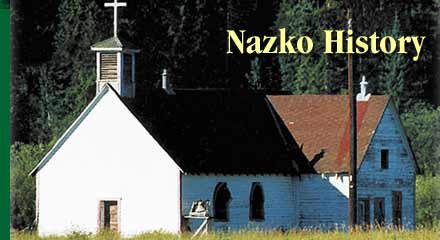|
|
 |
|
| Nazko History The Nazko Valley is within the traditional territory of the Carrier First Nation. The Chuntezni’i, Euchinico and Lhoosk'uzt'en bands of the Carrier have lived, travelled and hunted in the Nazko Valley since the beginning of time. Nazko means, " river flowing from the south." Fishpot Lake and the Nazko settlement were places for spring fishing. Trout Lake was a good winter fishing place. In the fall, caribou were hunted on the Itcha Mountains and dry meat made for the winter. The Carrier traded widely with the neighbouring tribes. On the Nuxalk Carrier Grease Trail goods (oolichan oil, dried meat, and obsidian) were traded over a 347-KM (158 miles) distance. In 1793, Alexander Mackenzie was guided by the Carrier, through the Nazko area, on the Grease Trail during his historic trip as the first to cross North America by land. From this moment, as one of the first encounters with Europeans, the lives of the Carrier people were destined to change dramatically. In 1892, the Nazko Valley reservations were formed and regulations imposed. At the same time the Roman Catholic mission was established.
Attempts were made at large scale cattle ranching, the peak was in the 40’s and 50’s. Joe Spehar, one of the largest, wintered about 500 head. A short growing season and distance to market were always barriers. Schools were built in 1950 by the ranchers and homesteaders and in 1960 by the Gov’t of Canada. In 1976, large-scale logging moved into the Nazko Valley, despite local disapproval. In 1984 electricity was brought to the Valley and in 1985 the Nazko Road was paved. Nazko entered the "Information super Highway" in 1999 when telephone and Internet service was finally provided. And in the year 2000, the new community centre was completed, to serve the 254 residents of the Nazko Valley. ____________________________________________________________________ |
|||
|
Historical Sights
|
|||
| Blackwater Homestead: The Blackwater Ranch owned by Joe Spehar, was one of the first homesteads in the Valley back in 1912. Most of the buildings on this site today are the original ones from this time. The main house was built by Joe Spehar, Fred Gilbert, and Jack Hudson in the 1950’s. The ranch at its peak covered 1501 acres of private land and wintered about 500 head of cattle. The Blackwater homestead is located on the Nazko Road cross the Blackwater Bridge on the right hand side of the road.
The Krestenuk trading post was set up in the 1920’s for the Nazko, Kluskus, and Trout Lake area until 1964. The main business was fur trading, supplies and was also used for a post office. The Trading post is located just past the Chuntezni’i Cemetery. It is the building furthest from the road. Old Red School House: The little red schoolhouse was originally located 10 km from where it is situated today at the Nazko Community Centre. It was the first provincial school, built in 1951. Francis Leake was a teacher from 1951–1974 in the Nazko Valley. In 1968 some portable classrooms were set up due to the expanding population. The log schoolhouse has remained a treasured symbol of our past ever since.
Chuntezni’i Cemetery: |
|||